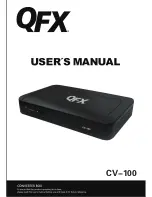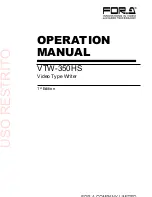
4-12-4. Response Message Terminator (Z)
To allow a wide variety of controllers to be used,
the terminator can be changed by sending the ap-
propriate command over the bus. The default value
is New Line (LF), End (EOI) sequence (mode Z0).
The terminator sequence will assume this default
value after receiving a DCL or SDC.
The EOI (END) line on the bus is usually set
low by the device during the last byte of its data
transfer sequence. In this way, the last byte is
properly identified, allowing variable length data words
to be transmitted. The Model 8020 will normally send
EOI during the last byte of its data string or status
word. The <Response Message Terminator> in model
8020 may be programmed by sending one of the
following commands:
Z0
= New Line (LF), END (EOI) terminator
Z1
= New Line (LF) terminator
Z2
= END (EOI) terminator
Z3
= No terminator
NOTES
1. Most controllers use the LF character to terminate
their input sequence. Using the NO TERMINATOR
mode (Z3) may cause the controller to hang up
unless special programming is used.
2. Some controllers may require that EOI be present
at the end of the string.
4-13. DEVICE STATUS REPORTING
Device status reporting defined by IEEE-488.2 builds
upon and extends the original specifications of the
status byte of the IEEE-488.1 document. A complete
model is defined for all status reporting. Figure 4-3
illustrates the IEEE-488.2 status reporting model
showing the IEEE-488.1 status byte, which can be
read by either a serial poll or Status Byte Query.
Summary of related common commands and queries
is given in the following.
*STB?
- Returns an NR1, which is the value of
the IEEE-488.1 status byte and the MSS (Muster
Summary Status) summary message.
*OPC
- Sets the Operation Complete event bit
in the Standard Event Status Register when all
selected pending device operation have been com-
pleted.
*OPC?
- Places a “1" in the output queue when
all selected pending operations are completed which
in turn cause the MAV (Message Available) summary
message to be generated.
*CLS
- Clears all Event Registers summarized in
the status byte.
*ESR?
- Returns an NR1, which is the value of
the Standard Event Status Enable Register.
*SRE
NRf - Sets the bits of the Service Request
Enable Register.
*SRE?
- Returns an NR1, which is the value of
the Service Request Enable Register.
4-14. STATUS BYTE REGISTER (STB)
The Status Byte Register contains the device’s STB
and RQS (or MSS) messages. IEEE-488.1 defines
the method of reporting the STB and RQS, but
leaves the setting and clearing protocols and se-
mantics for the STB message undefined. The standard
further defines specific device STB summary-mes-
sages.
A Muster Summary Status (MSS) message is
also provided which is output as bit 6 with the STB
response to a *STB? common query. The Status
Byte Register is altered only when the state of the
overlaying Status Data Structure is altered. The
description of the various bits within the Status Byte
Register is given in the following.
Bit 0
- Not Used
Bit 1
- Offset Error. The state of this bit indicates
whether or not an offset error occurred. Offset error
may occur when amplitude and offset parameters
exceed the instrument limits and the offset function
is turned on.
Bit 2
- Width Error. The state of this bit indicates
whether or not a pulse width error have occurred.
Width error may occur when the programmed pulse
width is larger than the programmed pulse period
parameter.
Bit 3
- Ramp Error. The state of this bit indicates
whether or not a ramp error have occurred. Ramp
error may occur when ramp parameters exceed the
instrument limits.
Bit 4
- Message Available Queue Summary Mes-
sage (MAV). The state of this bit indicates whether
or not the output queue is empty. The MAV sum-
mary-message is true when the output queue is not
empty. This message is used to synchronize infor-
mation exchange with the controller. The controller
can, for example, send a query command to the
device and then wait for MAV to become true. If
an application program begins a read operation of
the output queue without first checking for MAV, all
system bus activity is held up until the device
responds.
IEEE-488.2 Operation
Model 8020
Page 4-22
Содержание 8020
Страница 13: ...This page was intentionally left blank Model 8020 Table of Contents Page 8...
Страница 23: ...This page was intentionally left blank Installation Model 8020 Page 2 4...
Страница 93: ...Thispagewasintentionallyleftblank Parts List Model 8020 Page 8 10...
Страница 95: ......
Страница 96: ......
Страница 97: ......
Страница 98: ......
Страница 99: ......
Страница 100: ......
Страница 101: ......
Страница 102: ......
Страница 103: ......
Страница 104: ......
Страница 105: ......
Страница 106: ......
Страница 107: ......
Страница 108: ......
Страница 109: ......
Страница 110: ......
















































